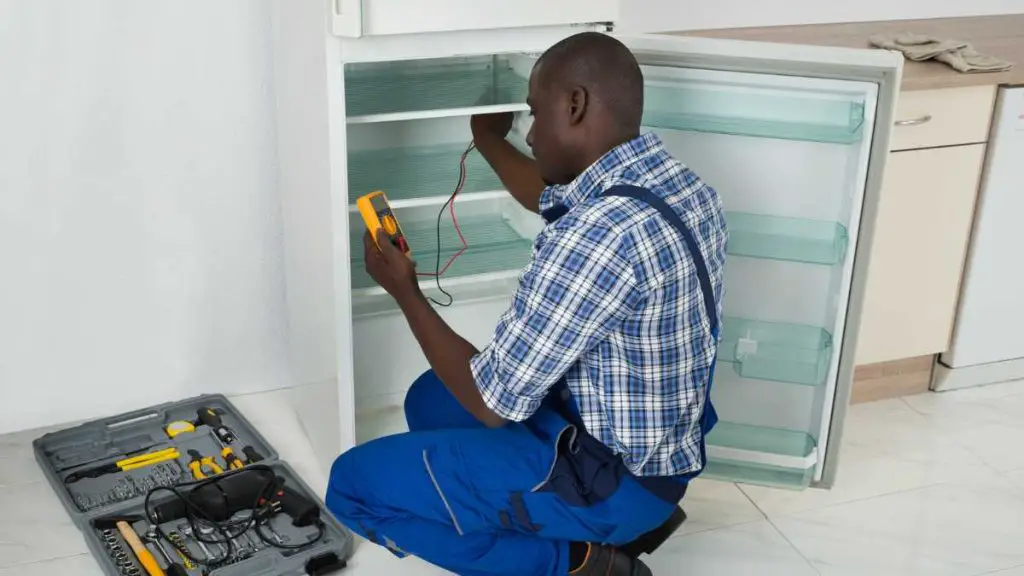How do modern refrigerators work? I bet you have a modern refrigerator from one of the popular refrigerator brands, and all you do is plug it in a socket and it works. But have you ever wondered what it takes for a refrigerator to work and function?
This home appliance has become an essential part of our homes and lives; and they keep all of our food and drink fresh, cool, and safe for consumption. If you ever thought about it, I’ll explain how modern refrigerators work, and what makes them function the way they do.
The Basics
At its core, a refrigerator is designed to remove heat from the inside of the unit and expel it outside. This process creates a cooling effect that keeps your food cold.
The main components of a refrigerator are:
- Compressor
- Condenser coils
- Evaporator coils
- Expansion valve

These parts work together to create a cycle that removes heat from the interior compartment and releases it into the surrounding environment.
Step -by-Step Process of How a modern refrigerator works
Here’s how it works step-by-step:
- The compressor compresses refrigerant gas (usually Freon) which increases its pressure.
- High-pressure gas flows through condenser coils where it cools down and turns into liquid form due to high pressure.
- The liquid refrigerant then passes through an expansion valve where it experiences a sudden drop in pressure causing evaporation.
- As the refrigerant evaporates, It absorbs energy in form of heat from surrounding air or objects leading to the cooling effect.
5. Refrigerant now returns back as low-pressure gas again towards the compressor where the whole cycle repeats itself.
This process continuously cycles until you turn off your refrigerator.
How Modern Refrigerators Cool?
Modern refrigerators use advanced technology such as digital sensors, and smart thermostats; some smart refrigerators even connect with WiFi so you can control temperature settings using your phone.
Some newer models also feature dual evaporator systems which allow for separate temperature controls between the freezer and fridge compartments resulting in better preservation quality for different types of foods stored separately on each side.
In addition, many companies nowadays incorporate special features like door-in-door designs that offer easy access to storage space without opening the entire fridge giving improved convenience while reducing energy loss and making it more efficient.
Electricity Consumption of modern refrigerators
Refrigerators are one of the most energy-consuming appliances in your home. On average, a fridge uses between 100 and 400 watts per hour. This translates to approximately $50-$100 annual electricity cost depending on where you live and how often you open/close doors or adjust temperature settings.
However, modern refrigerators have become more energy-efficient thanks to advancements in technology such as better insulation, and variable speed compressors which adjust cooling output according to usage patterns; thus saving money without compromising performance!
Keeping Your Refrigerator Cold: Best Tips
There are several things you can do to keep your refrigerator running efficiently:
- Keep the door closed as much as possible
- Don’t overload the fridge- make sure there’s enough space for air circulation.
3. Clean condenser coils every six months or so (depending on the model)
4. Avoid placing hot food directly into the fridge – let it cool down first.
5. Regulate temperature setting around 37°F (3°C) for fresh produce and dairy products while frozen items should be stored at below zero temperatures (-18°C).
6. Inspect the seal gasket regularly for damage or wear-and-tear that may cause air leaks resulting in loss of cooling efficiency.
7. Regularly defrost the freezer compartment if not frost free.
By following these tips, you can ensure that your refrigerator stays cold and runs efficiently.
Common Issues & Solutions
Even with proper maintenance, refrigerators may experience issues from time to time. Here are some common problems along with their solutions:
The Fridge is Not Getting Cold Enough
If your fridge isn’t getting cold enough even after adjusting temperature settings, cleaning coils, etc.; it could mean low coolant levels due to leakage. In this case, call a professional technician who will diagnose the problem by checking pressure levels using specialized equipment before adding/removing Freon gas.
Running Time
Modern refrigerators are designed to run 24 hours a day. However, newer models have become more efficient by using variable speed compressors that adjust cooling output according to usage patterns which means less energy consumption and quieter operation.
Refrigerant Usage
Modern refrigerators use eco-friendly refrigerants such as R600a or R290 which have lower global warming potential in comparison with older Freon-based coolants which were much more hazardous to the environment.
Fridge Compressor
The compressor is the heart of your refrigerator. It works by pumping refrigerant through the coils inside and outside of your fridge, forcing it to evaporate and then condense again. If you hear strange noises coming from your fridge or if it’s not cooling properly, there could be an issue with the compressor.
No-Compressor Refrigerators
Newer models of refrigerators do exist without compressors; they’re called absorption fridges. These units work differently than traditional ones since they don’t rely on mechanical parts like motors but instead use a heat source (e.g., gas) for the evaporation process. This makes them ideal for off-grid living situations where electricity may not be available at all times.
Ventilation Needs
Modern refrigerators need ventilation space around the back and sides so air can flow freely, allowing proper heat dissipation during the normal operating cycle. Therefore, make sure not to block airflow behind the unit when placed against the wall as it will affect its efficiency negatively over time!
Defrosting Process
In modern frost-free refrigerators defrost cycles are triggered automatically based on usage patterns monitored by smart thermostats/sensors embedded within appliance electronics; thus preventing ice buildup that may lead to damaged seals or even motor burnout due to overload caused by accumulated ice formation blocking circulation pathways.
Water Flow Through The Fridge
Some modern fridges come equipped with water dispensers /ice makers; these features require plumbing hookups usually located at the back side of the unit. Make sure to follow the manufacturer’s instructions carefully during the installation process as any mistake can result in water damage and potential electrical hazard.
Conclusion
Modern refrigerators have become an essential part of our lives. With their advanced technology, they keep our food fresh and safe for consumption while also being energy-efficient. Understanding how your refrigerator works will help you take better care of it, ensuring that it runs efficiently for years to come.






